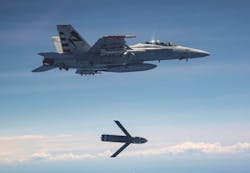Australia to arm nation's Super Hornet jet fighter-bombers with multi-mode sensor-equipped anti-ship missile
PATUXENT RIVER NAS, Md. – U.S. Navy airborne weapons experts are helping the armed forces of Australia arm that nation's F/A-18 E/F Super Hornet jet fighter bombers with the Lockheed Martin multi-mode sensor-equipped Long-Range Anti-Ship Missile (LRASM) for use against high-priority maritime targets.
Officials of the Naval Air Systems Command announced a $49.3 million order Friday to the Lockheed Martin Corp. Missiles and Fire Control segment in Orlando, Fla., for LRASM integration and test for Royal Australian Air Force F/A-18 E/F aircraft.
The Lockheed Martin AGM-158C LRASM is a subsonic anti-ship missile for use against high-priority enemy targets like aircraft carriers, troop transport ships, and guided-missile cruisers. Australia is acquiring LRASM capability as part of foreign military sales agreements.
LRASM is a joint project of the U.S. Defense Advanced Projects Agency (DARPA) in Arlington, Va., the U.S. Navy, and the U.S. Air Force to design an advanced anti-ship missile that can launch from the Navy F/A-18E/F Super Hornet jet fighter bomber, as well as from the Air Force B-1B Lancer long-range strategic bomber.
In the future LRASM also will launch from the F-35 Lighting II joint strike fighter, the P-8A Poseidon maritime patrol jet, as well as from the Navy Mark 41 shipboard Vertical Launch System. The missile travels at high subsonic speeds, and likely will give way in the future to expected new generations of hypersonic missiles. Submarine-launched versions are under consideration.
LRASM for Australia is designed to detect and destroy high-priority targets within groups of ships from extended ranges in electronic warfare jamming environments. It is a precision-guided, anti-ship standoff missile based on the Lockheed Martin Joint Air-to-Surface Standoff Missile-Extended Range (JASSM-ER).
Lockheed Martin has been designing LRASM for more than a decade, primarily under DARPA supervision. The advanced anti-ship missile is intended to replace the ageing Harpoon anti-ship missile. It has a multi-mode radio frequency sensor, a new weapon data-link and altimeter, and an uprated power system.
The LRASM can be guided toward enemy ships from as far away as 200 nautical miles by its launch aircraft, can receive updates via its datalink, or can use onboard sensors to find its target. LRASM will fly towards its target at medium altitude then drop to low altitude for a sea skimming approach to counter shipboard anti-missile defenses.
Related: Making sense of sketchy or incomplete information
The LRASM uses on-board targeting systems to acquire the target independently without the presence of intelligence or supporting services like Global Positioning System (GPS) satellite navigation and data links. Lockheed Martin is designing he missile with advanced counter-countermeasures to evade hostile active defense systems.
The Lockheed Martin LRASM has a 1,000-pound penetrator and blast-fragmentation warhead, multi-mode sensor, weapon data link, and enhanced digital anti-jam global positioning system to detect and destroy selected surface targets within groups of ships.
Lockheed Martin is in charge of LRASM overall development, and the BAE Systems Electronic Systems segment in Nashua, N.H., is developing the LRASM onboard sensor systems.
LRASM development is in response to a gap in Navy anti-ship missile technology identified in 2008. Before LRASM, the standard Navy anti-ship missile had been the subsonic Harpoon, which has been in the inventory since 1977.
Since LRASM started development, however, hypersonic cruise missiles able to fly faster than five times the speed of sound have become one of the Pentagon's top priorities. This has the potential to limit overall LRASM production numbers.
On this order Lockheed Martin will do its work in Orlando and Ocala, Fla.; California, Md.; and other U.S. locations, and should be finished by March 2026. For more information contact Lockheed Martin Missiles and Fire Control online at www.lockheedmartin.com, Naval Air Systems Command at www.navair.navy.mil, or the Royal Australian Air Force at www.airforce.gov.au.
About the Author
John Keller
Editor-in-Chief
John Keller is the Editor-in-Chief, Military & Aerospace Electronics Magazine--provides extensive coverage and analysis of enabling electronics and optoelectronic technologies in military, space and commercial aviation applications. John has been a member of the Military & Aerospace Electronics staff since 1989 and chief editor since 1995.
